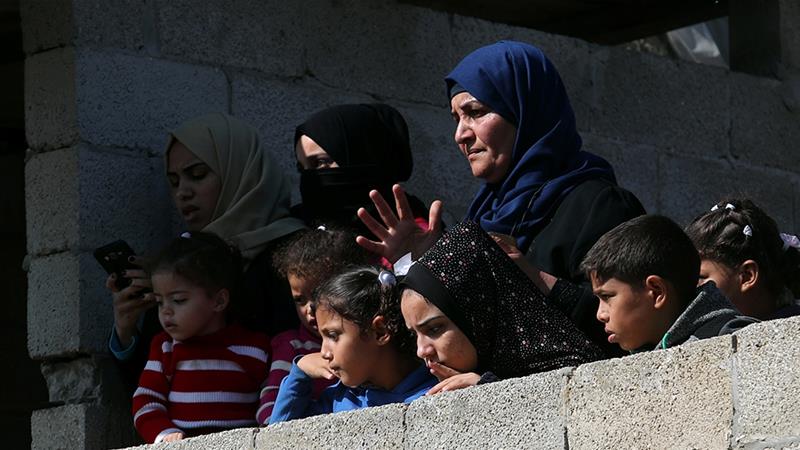As relative calm sets in, residents in besieged enclave say they have little faith in Egyptian-brokered ceasefire deal.
A fragile calm has taken effect in the besieged Gaza Strip as an Egyptian-brokered deal between Hamas, the group that governs the Strip, and Israel appears to be holding, but Palestinians and experts are sceptical of the agreement.
Mohammed Baroud, a 34-year-old schoolteacher, said he did not believe the latest ceasefire deal will last long.
“This is simply because Israel has never stuck to any agreement in the past,” Baroud, who has witnessed the previous three Israeli assaults on the enclave, said.
“My students, who are mostly 11-year-olds, were scared. I spent the day comforting them, reassuring them that it will all be OK,” he said.
“In reality, I know the Israelis will soon commit another crime.”
The truce, announced on Tuesday by Hamas-led factions, was designed to restore calm and end two days of Israeli aerial attacks on Gaza following an undercover Israeli operation that drew rocket fire from Palestinian factions. At least 14 Palestinians and two Israelis were killed in the two days of violence.
A statement by Palestinian groups in Gaza said: “Egypt’s efforts have been able to achieve a ceasefire between the resistance and the Zionist enemy.
“The resistance will respect this declaration as long as the Zionist enemy respects it.”
But Israeli Defence Minister Avigdor Lieberman resigned in protest against the ceasefire deal, precipitating a crisis for the coalition government led by Prime Minister Benjamin Netanyahu.
“What happened yesterday – the truce combined with the process with Hamas – is capitulating to terror. It has no other meaning,” Lieberman told journalists.
Netanyahu has defended the truce, saying that the “leadership is doing the right thing”.
‘We were all frightened’
On Tuesday night, an official statement issued by the Gaza Ministry of Education announced that schools were opening, indicating that the situation was returning to normalcy.
But 16-year-old Reem Khalla woke up with a feeling of trepidation on Wednesday morning.
Like many students in Gaza, Khalla was wary about attending school a day after the ceasefire, which came after intense Israeli bombing of the enclave that saw numerous buildings flattened, including a local television station.
“When I arrived, less than half of my classmates – about 15 people – were there,” Khalla told Al Jazeera.
“We were all frightened, and the teachers gave those who wanted to go home permission to do so,” she said.
“We didn’t even study much… We were mostly debating if the ceasefire will hold and whether this is going to be a rerun of the 2014 war.”
During the Israeli assault of 2014, more than 2,200 Palestinians were killed – the majority of whom were civilians – and tens of thousands were left homeless. Seventy-three people, most of them soldiers, were killed on the Israeli side.
Ceasefire ‘liable to hold’
Observers believe the agreement will hold, but only until the next round of attacks, which has been “postponed”.
“The latest ceasefire agreement is liable to hold because Israel paid a considerable price for its recent provocative attacks on the Gaza Strip,” Mouin Rabbani, a senior fellow at the Institute for Palestine Studies, told Al Jazeera.
“[Israel] fundamentally miscalculated in its assumption that Hamas would not retaliate in order to preserve the Egyptian-led mediation efforts,” Rabbani noted.
According to him, there will be significant pressure on the Israeli leadership to “perform more successfully” against the Palestinians.
“At the end of the day, Israel does not have credible political options vis-a-vis the Gaza Strip, but also appears unprepared to relinquish its blockade of the coastal territory,” Rabbani said.
Gaza, home to more than two million people, has been under a crippling Israeli and Egyptian-imposed blockade for 11 years that has severely restricted the movement of Palestinians.
Although Israel withdrew its troops and settlers from the Strip in 2005, it has maintained its control over Gaza’s airspace, territorial waters and land borders.
The siege has devastated the local economy, severely restricting the entry of food and access to basic services. It has also stopped the flow of construction materials needed to rebuild much of the enclave’s infrastructure which was damaged in the previous Israeli military campaigns of 2008, 2012 and 2014.
A ‘better deal’
Alaa Tartir, programme advisor at Al-Shabaka: The Palestinian Policy Network, believes the latest escalation by Israel was meant to “retest” the capabilities of armed groups in Gaza, which include Hamas’ al-Qassam Brigades.
The United States’ long-awaited Middle East “peace deal” pushed by US President Donald Trump’s son-in-law Jared Kushner has also played a role in the latest escalation and the subsequent truce, Tartir said.
“A wait-and-see approach will be pursued by all actors until the Trump administration announces the pillars of its ‘peace deal’,” Tartir told Al Jazeera.
“They [Israel] will continue to re-position themselves to secure a ‘better deal’ in the unfolding regional arrangements,” he said.
Following the announcement of the truce, the UN Security Council met behind closed doors to discuss the flare-up at the request of Kuwait and Bolivia.
But diplomats said an agreement was not reached on how to address the attacks.
Palestinian ambassador to the UN, Riyad Mansour, told reporters that the Security Council was “paralysed” and laid the blame on it for failing to take adequate and immediate action.
Additional reporting by Maram Humaid in Gaza
Source: Read Full Article
